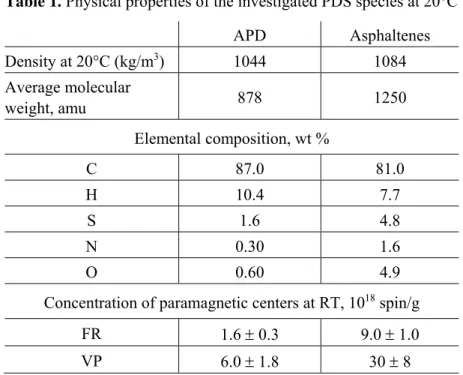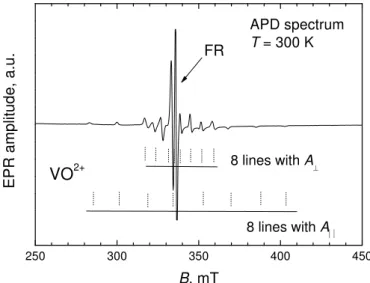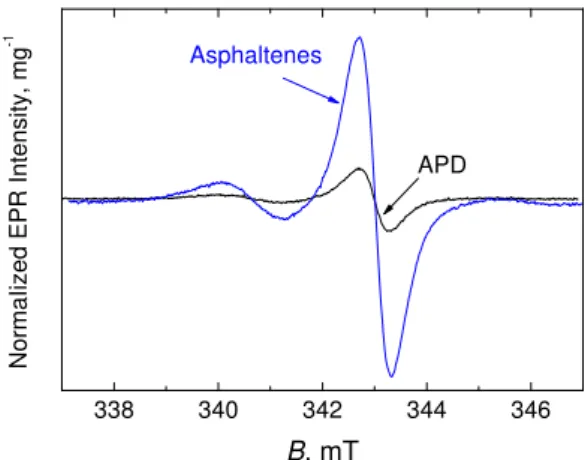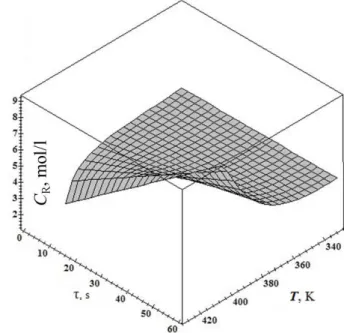Volume
18,
Issue
1
Paper No
16101,
1-7 pages
2016
http://mrsej.kpfu.ru
http://mrsej.ksu.ru
Established and published by Kazan University
Sponsored by International Society of Magnetic
Resonance (ISMAR)
Registered by Russian Federation Committee on Press,
August 2, 1996
First Issue was appeared at July 25, 1997
© Kazan Federal University (KFU)
*"
Magnetic Resonance in Solids. Electronic Journal
" (
MRS
ej
) is a
peer-reviewed, all electronic journal, publishing articles which meet
the highest standards of scientific quality in the field of basic
research of a magnetic resonance in solids and related phenomena.
MRS
ej
is free for the authors (no page charges) as well as for the
readers (no subscription fee). The language of
MRS
ej
is English.
All exchanges of information will take place via Internet. Articles
are submitted in electronic form and the refereeing process uses
electronic mail. All accepted articles are immediately published by
being made publicly available by Internet (
http://
MRS
ej
.kpfu.ru
).
*
In Kazan University the Electron Paramagnetic Resonance (EPR) was discovered by
Zavoisky E.K. in 1944.
Editors-in-Chief
Jean
Jeener
(Universite Libre de
Bruxelles, Brussels)
Boris
Kochelaev
(KFU, Kazan)
Raymond
Orbach
(University of
California, Riverside)
Executive Editor
Yurii
Proshin
(KFU, Kazan)
mrsej@kpfu.ru
editor@ksu.ru
Editors
Vadim
Atsarkin
(Institute of Radio
Engineering and Electronics, Moscow)
Yurij
Bunkov
(CNRS, Grenoble)
Mikhail
Eremin
(KFU, Kazan)
David
Fushman
(University of Maryland,
College Park)
Hugo
Keller
(University of Zürich, Zürich)
Yoshio
Kitaoka
(Osaka University, Osaka)
Boris
Malkin
(KFU, Kazan)
Alexander
Shengelaya
(Tbilisi State
University, Tbilisi)
Magnetic Resonance in Solids. Electronic Journal. 2016, Vol. 18, No 1, 16101 (7 pp.) 1
Concentration of paramagnetic centres at low-temperature thermal
destruction of asphaltenes
of heavy petroleum distillates
M.U. Dolomatov1, 2, A.A. Rodionov3, M.R. Gafurov3,*, A.V. Petrov4, T.B. Biktagirov3,
R.Z. Bakhtizin1, S.O. Makarchikov3, I.Z. Khairudinov4, S.B. Orlinskii3 1Bashkir State University, Validy 32, Ufa 450076, Russia
2Ufa State Petroleum Technological University, Kosmonavtov 1, Ufa 450000, Russia 3Kazan Federal University, Kremlevskaya 18, Kazan 420008, Russia
4Institute of Petroleum Refining and Petrochemistry, Iniciativnaya 12, Ufa 450065, Russia
*E-mail: Marat.Gafurov@kpfu.ru
(Received October 14, 2016; revised November 5, 2016; accepted November 8, 2016)
Changes of paramagnetic centers (PC) concentration in dispersed petroleum systems were studied in the process of low-temperature thermolysis. The kinetic model of PC concentration dynamics based on the processes of unpaired electrons formation during singlet-triplet transitions, weak chemical bonds dissociation and recombination of free radicals is proposed.
PACS: 75.20.-g, 96.20.Dt, 02.30.Hq
Keywords: petroleum disperse system, asphalt, asphaltene, paramagnetic centers, temperature dependence, EPR, ESR
1. Introduction
A typical petroleum fluid can be considered as a petroleum disperse system (PDS), i.e., a hybrid of a solution and a colloidal dispersion (of crystallizing waxes, self associating asphaltenes, etc.) [1]. The understanding of complex behavior of PDS under the thermal treatment is expected to be a challenge. Nevertheless, as it was stressed by Evdokimov et al., relatively simple experiments on only one of the PDS components can shed light on details of phase transformations in such systems [2, 3].
As one of the constituents of PDS, a paramagnetic phase can be the subject of interest: one gram of PDS contains 1016-1021 paramagnetic centers (PC) [4-6]. The majority of PC is concentrated in the high-molecular PDS components such as asphaltenes, resins and polycyclic aromatic hydrocarbons (PAH). The content of the high-molecular PDS components could reach the values of 45 wt % in native oils and up to 73 wt % in natural asphalts and bitumen [4]. Assuming that asphaltenes and resins have molecular weight of about 1000 amu [4], they could contain up to one unpaired electron per molecule.
To date there is no detailed description of the process(es) that would adequately describe the thermal generation-recombination of PC in PDS [7]. Among numerous additional motivations to investigate the processes of generation-recombination of PC in PDS, the most significant are related to understanding the mechanisms of photodegradation (the PC linewidth and radicals amount decreases with sunlight irradiation time of some hours [8]), as well as the discrepancies in the PC concentrations derived from the conventional and pulsed EPR measurements [9]. In this work we present a kinetic model that in our opinion could help to characterize the mentioned process(es).
2. Materials and Methods
Concentration of paramagnetic centres at low-temperature thermal destruction of asphaltenes…
2 Magnetic Resonance in Solids. Electronic Journal. 2016, Vol. 18, No 1, 16101(7 pp.) The samples were stored sealed in dark place at room temperature. No special procedures for the oxygen removing were conducted.
The APD group composition was determined from SARA (Saturated and Aromatic hydrocarbons, Resins and Asphaltenes) analysis using a Gradient-M chromatograph. The measurements of the dynamic viscosity were performed using a rotary viscometer Brookfield DV2 with a thermostatic cell in the temperature range of (20-160)°C. The deviation of temperature during the measurements did not exceed 0.5°C. Elemental analysis was done by X-ray fluorescence measurements (Spectroscan Max GV). The molecular weight was estimated by naphthalene cryoscopy [10].
EPR spectra of the samples were obtained using an ESP-300 spectrometer (Bruker) operating at 9.4-9.9 GHz (X-band) in continuous wave mode. Spectrometer’s magnetic field can be varied in the range of (20-1600) mT with an accuracy of not less than 0.01 mT. Modulation frequency was chosen to be 100 kHz. PC concentration was estimated at room temperature in the double cavity ER4105DR by comparing the integrated intensities of the spectra of a test sample and a reference sample (Cu-DETC solution) with the known concentration of PC. Samples heating was done in a stream of nitrogen blown through the quartz insert in the high-temperature resonator ER 4114HT equipped with the VT thermostatic system (Oxford Instruments). For each sample the temperature dependence of the EPR spectra in the range of (20-500)°C was obtained with (15-20)°C increment, heating rate 2°C/min and temperature setting accuracy of not less than 2°C [11, 12]. The chosen heating rate is slow enough to cause technical artifacts and allows to carry out the temperature experiments on a sample during a working day. Modulation amplitude 0.1 mT was chosen to investigate narrow EPR lines of free radicals. Microwave power level was equal to 1 W in order to avoid saturation effects.
3. Experimental results
Investigated APD contains saturated fraction of 8.5% by weight, aromatics of 58.6 wt %, resins of 30.4 wt % and asphaltenes of 17.8 wt %. Some physical and chemical properties for the investigated species are presented in Table 1.
Different models and corresponding equations for temperature dependencies of in PDS can be found in literature [13]. Our experimentally measured temperature curve for APD (which is not shown as a graph) can be adequately described by exponential decay based on the Arrhenius equation
Table 1. Physical properties of the investigated PDS species at 20°C
APD Asphaltenes
Density at 20°С (kg/m3) 1044 1084
Average molecular
weight, amu 878 1250
Elemental composition, wt %
C 87.0 81.0
H 10.4 7.7
S 1.6 4.8
N 0.30 1.6
O 0.60 4.9
Concentration of paramagnetic centers at RT, 1018 spin/g
FR 1.6 0.3 9.0 1.0
M.U. Dolomatov, A.A. Rodionov, M.R. Gafurov et al.
Magnetic Resonance in Solids. Electronic Journal. 2016, Vol. 18, No 1, 16101(7 pp.) 3
0 a
E RT
e
, (1)where η0 (3.0 1.2)1012 Pas, R is the ideal gas constant and Ea (86.1 0.6) kJ/mol is an
activation energy for PDS viscous flow.
The existence of PC is caused by the presence of d-metals (mainly V, Ni, Fe), delocalized
π-electrons of the aromatic rings and stable free radicals in PDS. EPR patterns in all the samples studied are very similar. Figure 1 presents that for APD. The EPR spectra originate from the paramagnetic vanadyl complex VO2+ in porhyrins (51V4+, 3d1, electronic spin S 1/2, nuclear spin I 7/2) which will be denoted as VP, and from the carbon free radicals (FR) [4, 5, 9, 12, 14]. Atoms in VP are arranged practically in a plane defining thus the g-factor and hyperfine A tensor of axial symmetry.
250 300 350 400 450
8 lines with A
EPR a
m
plitud
e,
a.u
.
B, mT
APD spectrum T = 300 K
VO2+
8 lines with A FR
Figure 1. EPR spectrum of APD at T 300 K. The lines belonging to FR and VP are marked.
The powder EPR spectrum of VP consists of the 16 “lines” representing the 2×8 hyperfine patterns (the projection of I is allowed to take 8 values: 7/2; 5/2; 3/2; 1/2) for the parallel and the perpendicular complex orientations. The parameters of EPR spectra at RT are g 1.962 0.001, g 1.986 0.001, A 16.6 0.8 mT, A 5.7 0.6 mT. The accuracy of determination of EPR parameters is defined by the
diversity of different structural classes of petroleum porphyrins in PDS [12, 14].
Detailed description of VP spectrum is given in [9, 12, 14]. The changes of VP EPR spectra at high temperatures (> 200°C) were investigated in details in [12]. As it follows from the present experiments, the intensity of VP EPR lines in the temperature range (20-200)°C practically obeys Curie law (see [4] and section Discussion). Accurate estimation of integral intensity of VP EPR spectrum at higher temperatures is tricky due to the mentioned EPR spectra transformation [11, 12] and is not done in the present research.
The EPR spectrum of FR is a single line with the linewidth of Hpp (0.52-0.58) mT located at
Concentration of paramagnetic centres at low-temperature thermal destruction of asphaltenes…
4 Magnetic Resonance in Solids. Electronic Journal. 2016, Vol. 18, No 1, 16101(7 pp.)
338 340 342 344 346
Asphaltenes
NormaIized
EP
R Intensity
, mg
-1
B, mT
APD
Figure 2. EPR spectra of FR in the investigated samples at T 300 K normalized by the sample masses.
1.5 2.0 2.5 3.0 3.5
1.0 1.2 1.4 1.6
1.8 APD
Asphaltenes
(
I
T
), a.u.
1000 / T , K-1
520 K
Figure 3. Dependencies of FR relative EPR intensities multiplied by the absolute temperature on the reverse absolute temperature.
4. Discussion
Temperature dependence of EPR intensity, I, for “free” radicals in PDS and other organic systems is conventionally explained by thermal activation of the singlet-triplet transition [4, 5, 15-17]:
INNc + Ns-t, (2)
where Nc 1T is a Curie demagnetization contribution due to the temperature increase,
st/ 2
s-t
1 3
E kT
N
e
is a contribution of the singlet-triplet transitions with the singlet-triplet transitionactivation energy Est. Physically, the term Ns-t in Eq. (2) counts for the formation/destruction of radical
pairs. Niizuma et al. have investigated the I(T) dependence for bitumen up to T 330 K and established Est 300(100) cm1 [17].
However, the experimental temperature dependencies of the FR EPR intensities (Figure 3) do not follow Eq. (1). Apparently, it is due to the FR generation and recombination. Carbon bonds weakened by conjugation with aromatic rings of asphaltenes and resins can be easily disintegrated, serving as sources of “free” radicals. The reverse process of FR recombination is also possible and should be taken into account
1 2 1 2
R R RR. (3)
Three factors can affect the rate of the FR concentration change:
s-t des rec
R dC
W W W
d , (4)
M.U. Dolomatov, A.A. Rodionov, M.R. Gafurov et al.
Magnetic Resonance in Solids. Electronic Journal. 2016, Vol. 18, No 1, 16101(7 pp.) 5
rate, Wdes for the rate of chemical bonds destruction and Wrec for the FR recombination rate.
Free radicals generation due to the break of carbon bonds can be described by the Eq. (5)
des/ des des 0des
E RT
M M
W
k C
k
C e
, (5)where kdes is a destruction rate constant of the weak bonds, СМ is the initial concentration of the
molecules before any dissociation, Edes is an activation energy of the bonds destruction, k0des is the
effective pre-exponential constant of bonds degradation rate.
The radicals in the liquid phase are surrounded by molecules, especially of the polynuclear aromatic type. The delocalized electrons of such large molecules have a “stabilizing” effect upon the free radicals. Together with the surrounding molecules, the radicals form so-called “cells”. In order to become “free”, the radicals need to migrate out of the cell. For that energy must be spent [16, 18]. We suggest that the rate of FR recombination in the liquid “cell” is equal to the diffusion rate [16]. Hence we have
2
2 2 2
rec rec diff
2 2
3000
R
R R R
RTC
W k C k C rDC
, (6)
where krec is a recombination rate constant, kdiff is a diffusion rate constant, D is a diffusion coefficient,
r is the distance between the molecules, R is the ideal gas constant, η is dynamic viscosity. Singlet-triplet transitions rate can be described by a first-order equation:
s-t/ s-t s-t 0s-t
E RT
R R
W
k C
k
C e
, (7)where ks-t is a rate constant for singlet-triplet transitions, Es-t is an activation energy for singlet-triplet
transitions, k0s-t is an effective pre-exponential constant of singlet-triplet transitions rate.
Taking into account Eq. (5)-Eq. (7), Eq. (4) can be re-written as an inhomogeneous differential equation for the concentration of radicals:
s-t des 2 / / 0s-t 0des 2 3000
E RT E RT
R R
R M
C RTC
k C e k C e
. (8)
The singlet-triplet transition activation energy of objects similar to the investigated PDS is 0.067 eV 540 cm1 6.5 kJ/mol [19]. In suggestion that kdes and ks-t are diffusion-controlled, we can
take their values in the range of 106-104 s1 [3, 19].
Bonds destruction activation energy for asphaltenes and resins ranges from 50 to 150 kJ/mol (an average of 100 kJ/mol) [3, 19]. It allows to evaluate an order of the effective pre-exponential constant of bonds degradation rate k0des as 108-1010, and an order of effective pre-exponential constant of
singlet-triplet transitions rate k0s-t as 105-103, respectively.
The initial concentration of the molecules disposed to dissociation into radicals, СМ 55 M
(mole/L), is taken as the total concentration of molecules containing a weak C-C bond (resins and asphaltenes) from the group analysis of the samples. Recombination rate constant krec was estimated
using dynamic viscosity data of Eq. (1): from the 0.01 at 158.8 Pa·s and T 60°С to ≈0.5 at
5.12 Pa·s and T 160°С.
Fixing the constants in the Eq. (8) to the mean values from the determined ranges, one can obtain the typical dependence of the FR concentration on temperature and reaction time with the initial condition СRC0R (Figure 4). It demonstrates non-linear character of the temperature dependence of
Concentration of paramagnetic centres at low-temperature thermal destruction of asphaltenes…
6 Magnetic Resonance in Solids. Electronic Journal. 2016, Vol. 18, No 1, 16101(7 pp.) The complex character of the temperature dependence of PC concentration can be ascribed to the existence of different competitive processes. From one side, the viscosity decrease means the higher rate (frequency) for the PC collisions. Therefore, with temperature and viscosity lowering, the recombination rate increases. From other side, the amount of PC increases with temperature and viscosity decrease because of the breaking of the chemical bonds weakened by conjugation with aromatic moieties of asphaltenes.
5. Summary
Based on the experimental findings, the kinetic model for the temperature dependence of concentration of paramagnetic centers (more specifically for “free” radicals concentration) is proposed. The model considers singlet-triplet transitions, weak chemical bonds dissociation as well as recombination of free radicals. The temperature dependencies of EPR spectra for “free” radicals are explained by the PC accumulation and recombination processes. Evidently, it is only the first step for correct description of PDS changes during the thermal treatments using native paramagnetic centers as sensitive spin probes. We are planning to address the following issues such as the experimental or numerical estimation and physical meanings of some of the parameters introduced (as a reaction time, for example), influence of PDS content, influence of oxygen and of the way of the samples thermal treatment on the EPR spectra of PDS in our next publications.
Acknowledgments
The work was funded by the subsidy of the Russian Government to support the Program of competitive Growth of Kazan Federal University among World’s Leading Academic Centers and by the Project Part of the state support of Ministry of Education of Russian Federation.
References
1. Syunyaev Z.I. Chem. Technol. Fuels Oils16, 484 (1980)
2. Evdokimov I.N., Eliseev N.Yu., Eliseev D.Yu. J. Petrol. Sci. Eng. 30, 199 (2001)
3. Evdokimov I.N., Eliseev N.Yu., Eliseev D.Yu. Fuel83, 897 (2004)
Figure 4. 2D plot of the FR concentration dependence on temperature and reaction time calculated from Eq. (8). The values of the parameters in Eq. (8) are k0des 109, k0s-t 104, Es-t 6500 J/mol,
M.U. Dolomatov, A.A. Rodionov, M.R. Gafurov et al.
Magnetic Resonance in Solids. Electronic Journal. 2016, Vol. 18, No 1, 16101(7 pp.) 7
4. Asphaltenes and Asphalts, 2, edited by Yen T.F. and Chilingarian G.V., in Developments in Petroleum Science, Volume 40, Part B (Elsiever, 2000), 621 p.
5. Asphaltenes and Asphalts, 1, edited by Yen T.F. and Chilingarian G.V., in Developments in Petroleum Science, Volume 40, Part A (Elsevier, 1994), 459 p.
6. Volodin M.A., Mamin G.V., Izotov V.V., Orlinskii S.B. J. Phys.: Conf. Ser. 478, 012002 (2013)
7. Wang W., Ma Y., Li S., Shi J., Teng J. Energy Fuels30, 830 (2016)
8. Guedes C.L.B., Mauro E.Di, Campos A.De, Mazzochin L.F., Bragagnolo G.M., Melo F.A.De, Piccinato M.T. Int. J. Photoenergy2006, 1 (2006)
9. Mamin G.V., Gafurov M.R., Yusupov R.V., Gracheva I.N., Ganeeva Y.M., Yusupova T.N., Orlinskii S.B. Energy Fuels30, 6942 (2016)
10. Dolomatov M.Yu., Mukaeva G.R., Shulyakovskaya D.O. J. Mater. Sci. Eng. B3, 183 (2013)
11. Galukhin A.V., Khelkhal M.A., Gerasimov A.V., Biktagirov T.B., Gafurov M.R., Rodionov A.A., Orlinskii S.B. Energy Fuels30, 7731 (2016)
12. Biktagirov T.B., Gafurov M.R., Volodin M.A., Mamin G.V., Rodionov A.A., Izotov V.V., Vakhin A., Isakov D., Orlinskii S.B. Energy Fuels28, 6683 (2014)
13. Daučík P., Višňovský J., Ambro J., Hájeková E. Acta Chimica Slovaca1, 43 (2008)
14. Gilinskaya L.G. J. Struct. Chem.49, 245 (2008)
15. Valyavin G.G., Fryazinov V.V., Dolomatov M.Yu., Artamonova E.V. Chem. Technol. Fuels Oils 3, 54 (1980)
16. Dolomatov M.Yu., Shulyakovskaya D.O., Mukaeva G.R., Paymurzina N.K. Appl. Phys. Res. 4, 83 (2012)
17. Niizuma S., Steele C.T., Gunning H.E., Strausz O. P. Fuel56, 249 (1977)
18. Raseev S. Thermal and Catalytic Processes in Petroleum Refining, Marcel Dekker, Inc., New York (2003)
19. Almusallam A.S., Shaaban M., Nettem K., Fahim M.A. J. Disp. Sci. Tech.34, 809 (2013)
20. Scotti R., Montanari L. Molecular Structure and Intermolecular Interaction of Asphaltenes by
FT-IR, NMR, EPR in Structures and Dynamics of Asphaltenes, edited by Mullins O.C. and



